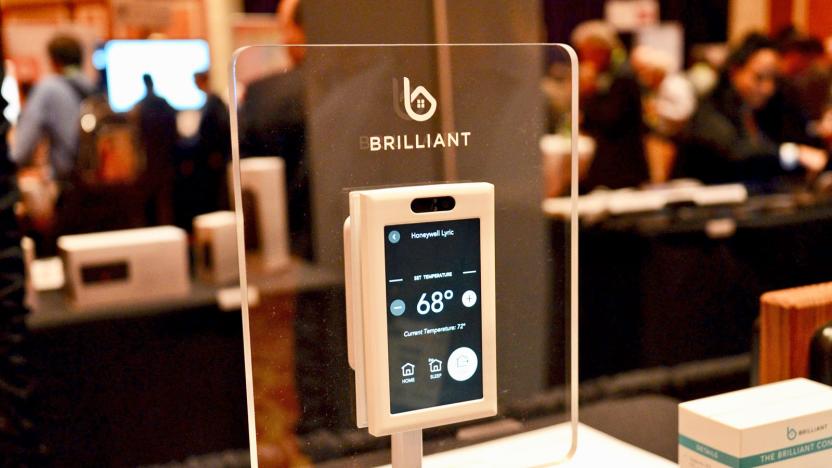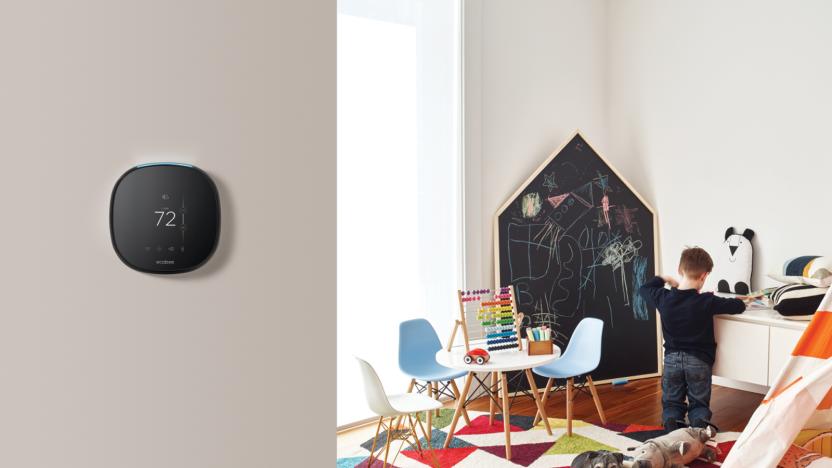lightswitch
Latest

Belkin's latest Wemo light switches work natively with HomeKit
Until now, using one of Belkin's Wemo Light Switches with Apple's HomeKit has meant attaching a bridge. No more: Belkin is introducing new Light Switches that take advantage of Apple's software-based authentication to offer native HomeKit support. In other words, you don't have to think much about your setup -- you can flick a switch and know that it'll turn on all the lights in your Home app rooms. This isn't completely novel (Philips added HomeKit support to the Hue Tap in 2017), but it's certainly helpful.

Brilliant turns your light switches into connected-home hubs
Brilliant plugs directly into your home's existing light-switch ports, and it controls a slew of smart home devices, including lights, the Ring doorbell, Nest thermostat, Sonos speakers, Amazon Alexa and more. This is a control panel built for everyday folks, rather than businesses, and it has a price to match. A single Brilliant panel starts at $200 and maxes out at $350 for a four-switch set (that's $50 for each additional switch). The whole shebang will be available at the end of February.

Ecobee's Alexa thermostat is essentially a wall-mounted Echo
If you're Ecobee and you have to compete against an Alphabet-backed heavyweight like Nest in the smart home space, what do you do? Simple: add built-in voice control that Nest can't currently match. The new Ecobee4 thermostat incorporates Amazon's Alexa. That gives you hands-off control over your home's climate, of course (such as saying when you're away), but it also turns your thermostat into a sort of wall-mounted Echo -- you can use just about any Alexa skill that makes sense. If you want to set a reminder or fetch a recipe, you might not need a separate device.

Finally, a light switch so green it doesn't need electricity
It's not very often that a light switch really catches Engadget's eye, so you know it has to be something clever to show up on our virtual pages. This particular lightbulb activation device (as demonstrated by NXP) is not only wireless, it's powerless -- we were able to turn on a wireless lightbulb simply by tapping on the switch itself, without requiring an external power source. This one single action alone actually generates just barely enough power to push a signal to the bulb. The unit we played with also utilizes NFC to pair wirelessly with a light source. All told, it worked without a hitch, and the tech is currently being sampled out to manufacturers. This means we'll likely start seeing devices take advantage of this setup sometime this year, so be on the lookout for more details as they come out.

Belkin ships WeMo Light Switch for $50, launches matching Android app
Belkin promised a simple approach to connected lighting when it unveiled the WeMo Light Switch back at CES, and the company is making good on its word by releasing the switch today. The WiFi-based controller is now available both online and at retail shops for $50. It isn't arriving alone, either -- Belkin is simultaneously launching the finished version of its free WeMo app for Android to complement the existing iOS release. If you'd rather have smart switches than smart light bulbs, the new WeMo hardware awaits at the source link; the companion Android app should be available shortly.

ThinkGeek's Power-Up brings the arcade controls to your room's light switch
Sure, you could get one of Think Geek's iCade controllers to play actual arcade-style button mashing games -- or you just bring the nostalgia of the joystick to your light switch for $30 with its recently introduced Power-Up Arcade light switch plate. The unit can replace any standard light switch plate, turning it into a faux gaming control panel. A traditional joystick replaces your old switch nub to control the lights, while its two action buttons enable "pew pew" sound effects when pressed. If all that wasn't enough, the Power-Up also acts as a nightlight after you use it to pwn hit the main lights in your quarters (you'll have to provide of a duo of AA batteries yourself). Check out the video below to see it in action for yourself.

Insert Coin: Luminode dimmer switch runs on a mesh network, learns to light up our lives (video)
In Insert Coin, we look at an exciting new tech project that requires funding before it can hit production. If you'd like to pitch a project, please send us a tip with "Insert Coin" as the subject line. Just a simple light switch, you say? Look closer. Think Automatic's Luminode dimmer switch hides both a processor and a mesh network connection that lets every switch in the home coordinate with each other. A multi-tap system makes it possible to link multiple lights together without extra wiring or complex programming, but that's just the start: it's possible to create "scenes" of predefined lighting levels and, with a USB adapter, hook up to home automation systems (including Think Automatic's own) that can learn usage habits, track energy consumption or simply let us control the array with our smartphones. The platform uses raw XML to communicate and already talks to GE, Insteon and Stargate hardware -- all without requiring a huge grid of buttons or displays. Development of the Luminode is very nearly done after six-plus years of work in Seattle. The hardware is fundamentally ready and just needs the Kickstarter project to finish its FCC and UL testing along with the obligatory mass production. The hope is to start delivering switches in January as well as integrate more closely with non-lighting elements in the future. Pledge levels are dictated almost exclusively by volume: $130 is what it takes to get a basic two-switch kit, $260 will add the USB adapter along with an extra switch, and successive levels scale all the way up to a 50-switch, $3,000 kit for large homes. Think Automatic has a relatively low $35,000 threshold to meet its Kickstarter funding, but it only has 13 days left to go. If you like the idea of advanced lighting that doesn't require an advanced appreciation of the user manual to understand, now's a good time to click the source link and make it happen.

SmartSwitch prototype makes work out of the simplest of things
Conserving energy is one of those things that you may want to do, but you've never gotten around to it, and you're not exactly sure how to start -- because, well, thinking about stuff is hard. The SmartSwitch prototype -- designed by Peter Russo and Brendan Wypich at Stanford University -- works on just that idea: turning lights on and off is a reflexive action that you barely think about... unless you get some resistance. The modded light switch is equipped with a network connection and a brake pad, and each time you try to turn on a light in your home, it makes a judgment about the overall current electricity levels being used, and gives resistance, making the switch harder to turn on, if the network determines the levels of usage to be high. Check out a video of how the whole thing works after the break.[Via Hacked Gadgets]

Wall-mounted touchpad light switch ends accidental in-home raves
Flipping on a light switch usually doesn't require much in the way of cranial fortitude, but mount three or four of the things in a row and it's Concentration time whenever you try to flick the right one. Japanese graphic designer Mac Funamizu feels your shame, imagining a conceptual wall-mounted touchpad to end the confusion and inadvertent light shows. With his invention you'd simply drag your finger toward the light you want to turn on, do it again to turn it off, or make a circular sweep to illuminate the whole room. It certainly seems a bit more useful than other switches we've covered in the past, but until we see a version that will register our gestures from the couch we'll stick with our Clappers, thank you very much. Update: Taku commented to point out a strangely similar though seemingly completely unrelated prototype from London-based designer Edward Horsford. It offers the same functionality plus adds ridges.[Via Engadget German]



